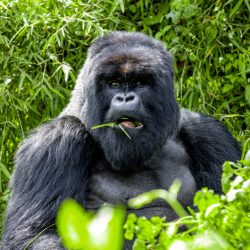Living the 2010 Gorilla Census Experience In Team 2
Blog | 18/05/10
From March 1st to April 27th, 2010; there has been a mountain gorilla census in the Virunga Massif. Mountain gorillas are a critically endangered Great Ape species that remained unknown to the Western world until October 17th, 1902 when Captain Robert von Beringe discovered and brought them to the Western attention. Since their discovery, mountain gorillas of the Virunga Massif, one of their 2 last habitats, have been subject to different human induced threats including poaching, habitat destruction, and the trade of baby gorilla. The census exercise helps to understand the mountain gorillas’ population dynamics.
This story tells the experience of Team 2 that worked mainly in the Volcanoes National Park, Rwanda. From March through April, much of Volcanoes National Park’s 160 km2 of land was quietly covered by trackers who were carrying out the 2nd gorilla census of the Virunga Massif within the past decade. All eyes of Virunga Massif’s conservationists and park managers were oriented throughout the amazing landscapes of Rwanda’s first national park. VNP’s wildernesses, with elevations ranging from 2500 to 4503 meters, have been covered.
Our first day of the census started on March 2nd at six in the morning after three days of field training in Bukima, DRC. Following the training all trackers traveled to the part of the forest they were to start work in. On the one hand the forest was familiar to all of us; on the other hand we were learning new methods for the census activity. This methodology consisted of using reconnaissance trails that were a distance of 500 meters apart when walking in the park. Using reconnaissance trails in this way helps in maximizing the chance of observing the targeted population. Map, compass and GPS are the equipment used to direct and orient people in the forest, which was a challenge as some of us were not used to utilizing this kind of technology when we’re in the park.
On March 6th, we started by climbing Karisimbi (white shell), the highest and probably the most beautiful of the Rwanda volcanoes! This volcano, with its altitudinal vegetation zones is probably one of the most beautiful mountains of the world. Here every body sweated to reach the last and highest point of the reconnaissance trail at 3800 meters of altitude. The main obstacles were slopes and deep ravines. The tiredness we have had that day didn’t prevent us to look around and explore the stunning scenery and fascinating vegetation. The day ended at 6 pm and each member of the team was asking himself if we will endure for the whole exercise.
The following 4 days contributed in showing to us that all planed activities and itineraries were subjects to change without any prior notice. The day we were visited by National Geographic team for photographing the census, we have had an extraordinary good moment with these veteran photographers. At the end of the day as it was getting darker and darker in the park, we remarked that except Matthias, one of our visitors; none of us has a torch. This experience showed us the importance of planning accordingly for a day in the park because when you’re in the park you don’t know what the hours will bring. My team will keep remembering the good moment we have spent with Mathias team and how his torch saved us when the night was falling.
On March 8th, we had the chance of observing for the first time the old nests of gorillas’. Everybody can guess how happy we were that time because we were approaching our target of finding mountain gorillas and starting to count them. Unfortunately, that day ended by fear from bees. Four member of the team, including myself were bitten by bees from a hole in a tree. But we haven’t been discouraged by these challenges because we were determined and prepared for such experiences. One thing to note is that our colleague, Christopher, has been bitten by bees 3 times during the whole exercise and has given the name of “Mr Bees”.
My team will not forget the day we found the lone silverback who is suspected to be Bikwi, a former member of Susa group. He attacked us and some of us were about to run but instead we took the time to teach each other how to behave in such circumstances. Thanks must go to one of our colleagues whose name is Erick. Without his advice we shouldn’t have escaped the danger from this silverback which wanted to protect his home range.
The most unforgettable day to me for the whole census is April 13th when we were attacked by the biggest animal of African parks, the elephant. We have been saved by the fact that we were aware that elephants were in that zone and we took serious actions to hide ourselves from its view before it saw us.
Let me express my thanks to the brilliant trackers who accompanied me on this activity in my group. Some of us were doing this activity for the first time in our conservation career but we believe that this period we spent in the park will contribute to make a difference by showing that the number of gorilla has increased.


